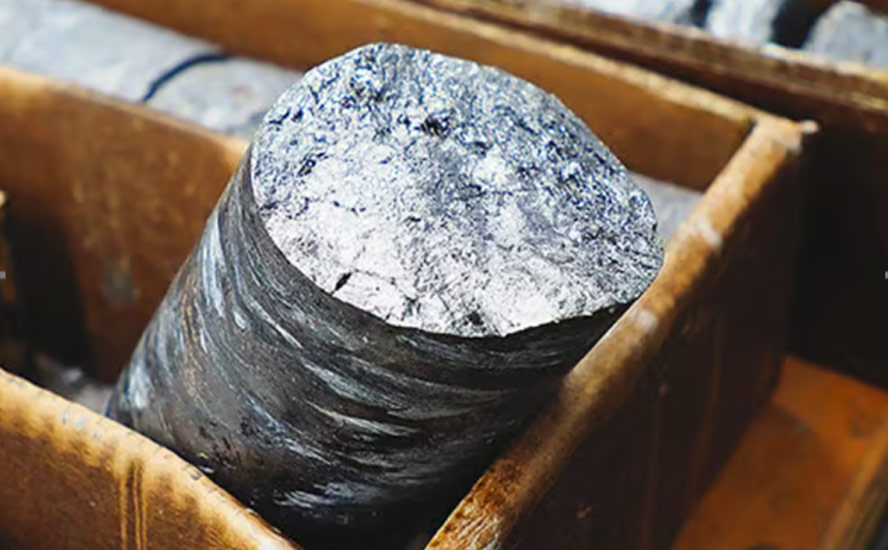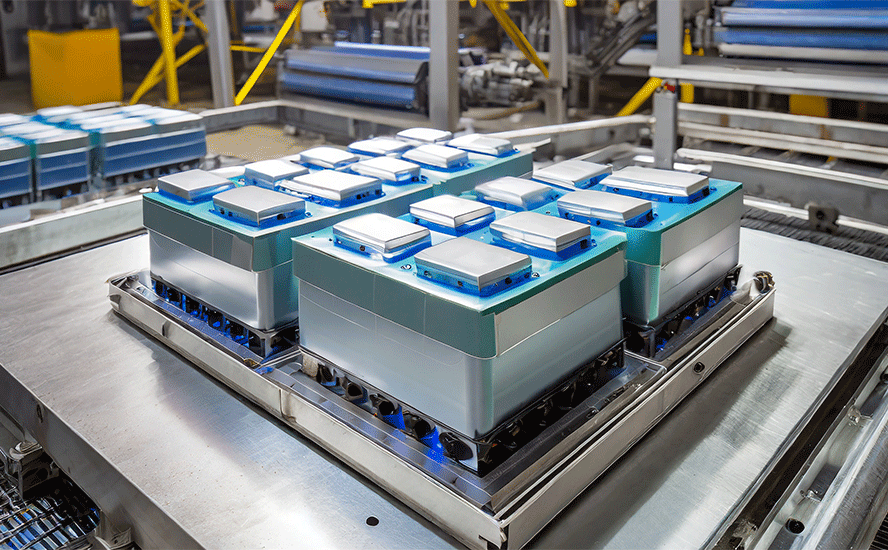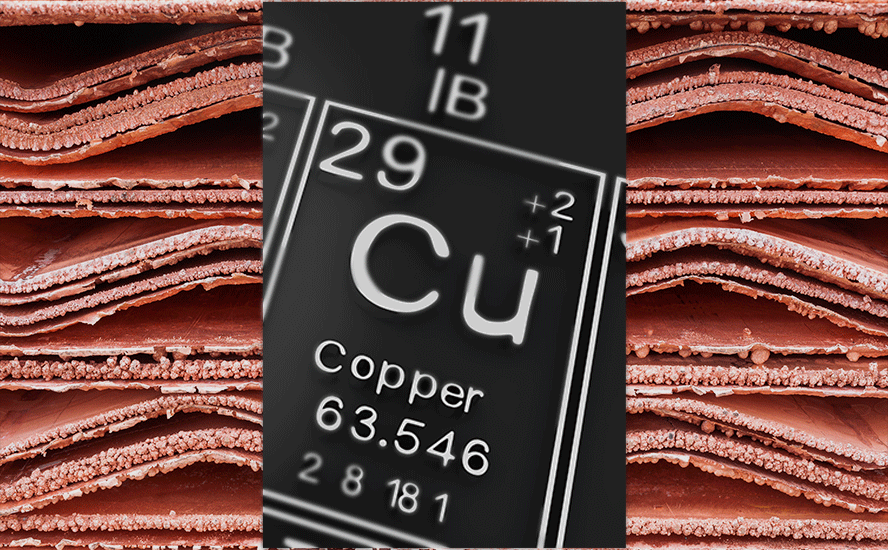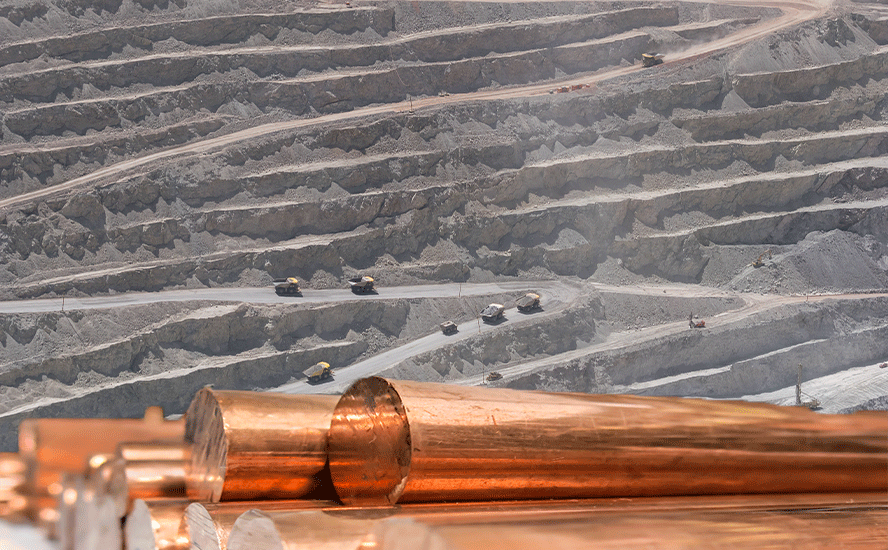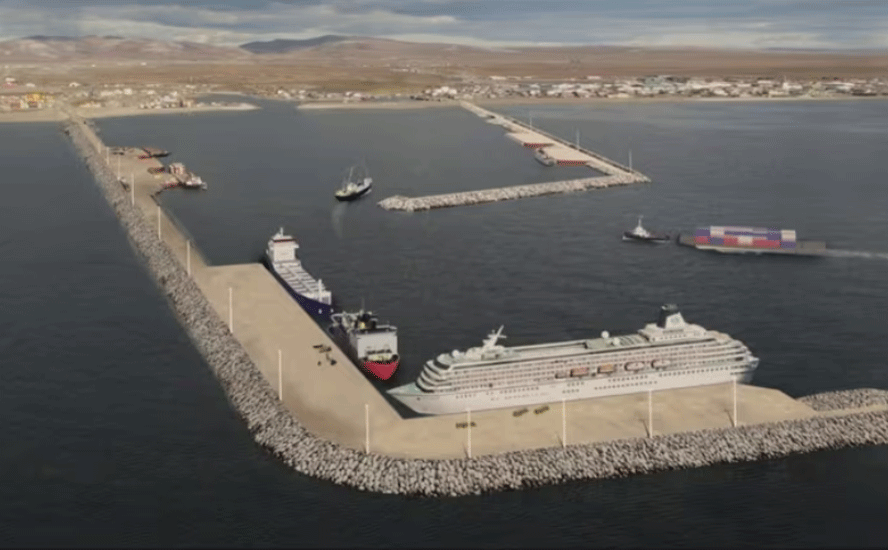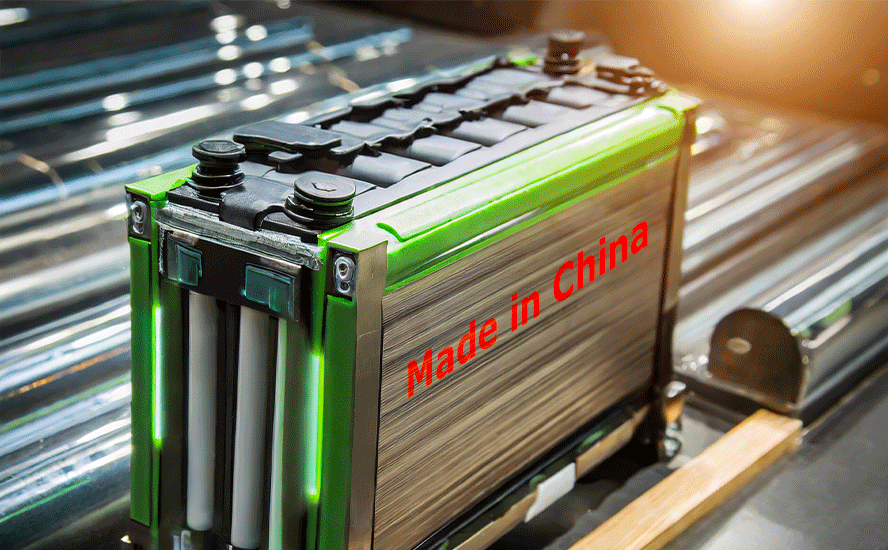Pampa Metals exploring potential porphyry district on trend with Escondida, the world’s largest copper mine
2022.05.07
Around 80% of Chilean copper production comes from copper-moly porphyry deposits, with most situated in northern Chile. These porphyries, which may contain minor gold and often have minor silver by-products, provide the ore for some of the world’s most prolific and highest-grade copper mines.
Among the largest are Chuquicamata, Escondida and Collahahuasi.
Chile is an ideal “elephant” copper deposit hunting ground for the big-name mining companies. Boasting the biggest copper reserves worldwide, at 200 million tonnes, means Chile’s dominance isn’t waning anytime soon.
Several metallogenic belts developed, reflecting changes in the tectonic setting and igneous activity. They include the Miocene High Cordillera Belt, the Mid-Tertiary Domeyko Cordillera Belt, the Paleocene Central Belt, and the Mesozoic Coastal Belt
Naturally, given northern Chile’s copper riches, some of the mining industry’s largest red-metal producers have flocked to the region.
Chilean state-owned Codelco operates El Teniente in central Chile, the world’s largest underground copper mine, along with Chuquicamata in northern Chile, historically one of the world’s largest and deepest open pit mines (mining has been carried out over more than 100 years), now transitioning to a giant underground block cave operation.
Other major copper miners, who have undertaken significant exploration and production, include BHP, Freeport McMoran, Rio Tinto and Antofagasta Minerals. The latter has four operating mines in Chile including its flagship Los Pelambres in the Coquimbo region.
Escondida, owned by BHP, Rio Tinto and a Japanese consortium headed by Mitsubishi, is the largest copper mine in the world (and the largest producer of copper cathodes and concentrates) while Collahuasi, another top Chilean copper mine, is jointly owned by Anglo American, Glencore and Mitsui.
In recent years, there has been an influx of junior miners looking for the next big copper discovery in Chile.
One of the most promising, imo, is Pampa Metals (CSE:PM, FSE:FIRA), which controls a 100% interest in eight exploration projects prospective for copper and gold in northern Chile.
These projects (Arrieros, Block 2, Redondo-Veronica, Block 3, Block 4, Cerro Buenos Aires, Cerro Blanco and Morros Blancos) are all located along proven mineral belts of the Atacama region, including the Central Paleocene and Domeyko belts that have dominated the world’s copper production.
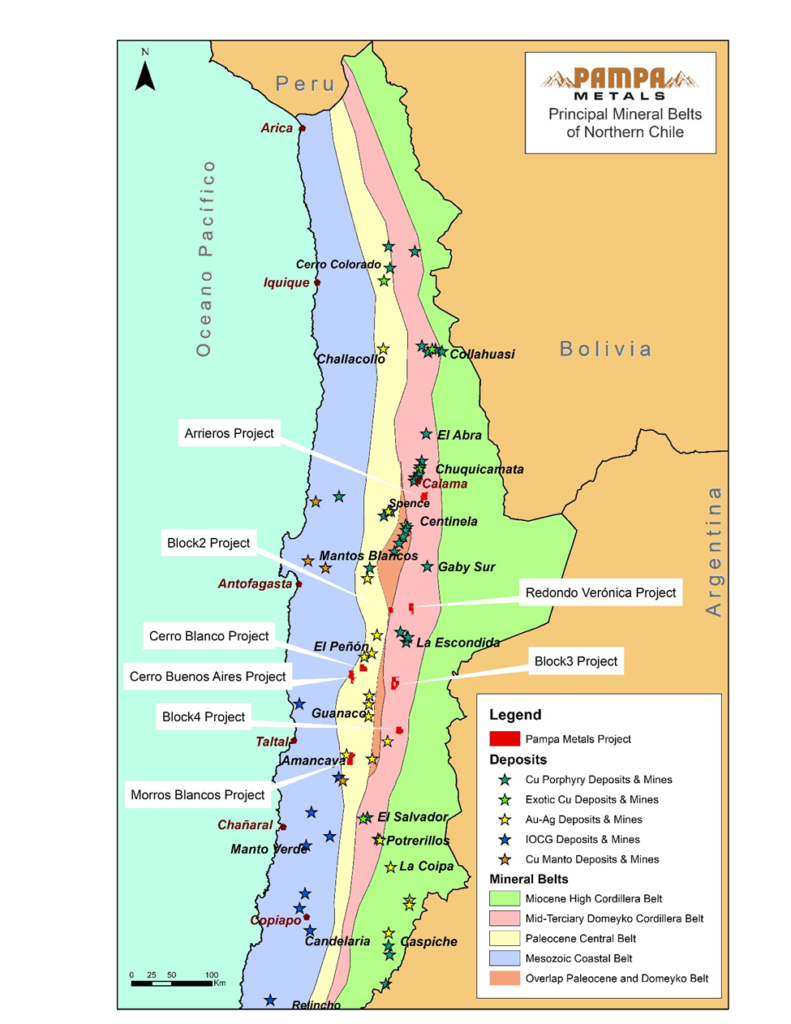
As shown on the map above, five of the projects are situated along the mid-Tertiary porphyry copper belt of northern Chile — the Domeyko Cordillera — that is host to three of the world’s top five copper mining districts at Collahuasi, Chuquicamata and Escondida (the world’s biggest).
The remaining three are located in the heart of the Paleocene mineral belt, which hosts a series of important porphyry copper deposits and mines such as Cerro Colorado (BHP), Spence (BHP), Sierra Gorda (KGHM & Sumitomo) and Relincho (part of Nueva Union – Teck-Goldcorp).
The Chilean Atacama Desert is characterized by elevated ranges of mountains, separated by relatively flat, piedmont-gravel-filled “pampas” that conceal the underlying geology.
These “pampa” areas remain underexplored because they contain a layer of gravel, anything from 20m to > 250m thick,, that was deposited after the formation of the porphyries. A rough estimate suggests at least 50% of northern Chile is covered by pampas, meaning that half of the region’s undiscovered mineral deposits may be concealed by a thick gravel cap.
Notwithstanding the important discoveries noted above, there are still very large areas of untested pampas in northern Chile that have the potential to conceal significant mineral deposits.
Outcrops in the pampas are rare, however if found, they can display similar characteristics, in terms of geology and hydrothermal alteration, as copper porphyry deposits. Pampa Metals’ game plan is to first conduct geological surveys to understand the outcrops, then carry out geophysical programs to explore the pampas, and then drill them.
Block 4
Of the eight projects, one that has rapidly become a priority is Block 4, located 220 km southeast of Antofagasta and 110 km south of the giant Escondida copper mine.
The 6,800-hectare project lies along the above-mentioned Domeyko Cordillera copper belt that is host to three of the world’s top five copper mining districts at Collahuasi, Chuquicamata and Escondida.
Last year Pampa Metals began exploring Block 4 with a magnetic survey similar to what was done at its other properties, followed by detailed mapping of the available outcrops. The geological team’s interest was piqued when they noticed a discrete, isolated magnetic high, smack dab in the middle of the property.
While the outcrop was poorly exposed at surface, intense quartz veinlet stock workings were visible, prompting further investigation.
“These quartz veinlets that we see in these porphyries and sometimes in the surrounding host rocks, are critical and characteristic of these copper porphyry systems that we’re looking for, and this was very exciting to us,” Pampa Metals’ Director Timothy Beale told me in an interview earlier this year.
“The coincidence of this, with the magnetic high, tells us things about the potential porphyry system we might be looking at here. The historic exploration has been very limited wide-spaced trenching, with a few old drill holes that we believe date back to the 1980s or ‘90s. We don’t have any results from this work but these old trenches and drill holes were focused on quite a number of little copper oxide occurrences, so we know we have copper mineralization in the general vicinity but the actual porphyry and quartz veinlet stock work zone coincident with magnetic anomaly that we’ve found, has never been drill-tested, trenched or explored historically.”
Follow-up field work led to the discovery of a stockwork veined porphyry intrusion, spatially coincident with the magnetic anomaly detected by Pampa’s ground magnetics survey. The new target was named Buenavista.

Last November-December, six trenches totaling 2.3 km were excavated, over a 1 km-diameter area, with 202 samples collected.
In March, Pampa reported assay results up to 0.26% copper, including 24 meters @ 0.14% Cu, and up to 0.64 grams per tonne gold, including 24m @ 0.25 g/t.
This was followed by the company’s announcement this week that a large-scale soil sampling program has been initiated, together with a plan for a first-pass drill program at Buenavista.
According to Pampa, “Results to date have revealed a central porphyritic intrusion, associated with an intense quartz-veinlet stockwork, a discrete magnetic anomaly, and highly anomalous Cu-Mo-Au geochemistry from limited trenching, all supporting the possible presence of a productive Tertiary porphyry copper style system.”
Given the lack of large rock outcrops at Buenavista, and the presence of shallow <5m) soil cover, the area is ideal for a soil geochemical survey that Pampa hopes will help to delineate the patterns of the copper-moly-gold anomalies identified from trenching. The survey should also help to refine the planned drill program, expected to start around September, and to identify new drill targets.
Approximately 2,500 soil samples, on a 100m x 50m grid, are expected to be taken over a 3.5 x 3.5 km area centered on the Buenavista target and stockwork zone.


Two important pieces of information gleaned this week from the news release, and in conversation with Pampa Metals’ CEO Paul Gill, lead me to believe that Pampa is in the early stages of uncovering what could be a new porphyry district in northern Chile, the epicenter of the world’s copper production.
The first bit of evidence, as is the case for many mining properties, concerns location, location, location.
The Domeyko Fault Zone running parallel to the Andes and through the Escondida district 110 km to the north, is the same fault zone that bisects Block 4. Along its length, the Domeyko Fault Zone is an important control on most of the large porphyry deposits located along it.


Discovered in 1981, the Escondida district contains at least 144 million tonnes of copper and includes four major copper porphyry deposits: La Escondida, Escondida Este, Escondida Norte-Zaldívar and Pampa Escondida.
Block 4 is located along the same copper belt as the Escondida district, the Mid-Tertiary Domeyko Cordillera Belt depicted in pink in the above map.
Could Block 4 host a new copper district with the same or similar geology as some of the largest copper deposits in Chile, such as Escondida, Chuquicamata, El Abra and Collahuasi to the north, and El Salvador and Potrerillos to the south?
Of course it’s too early to say, but we are encouraged by the second piece of evidence pointing to a district-wide copper system.
According to Pampa Metals, several magnetic anomalies with similar features to Buenavista occur under post-mineral cover to the east and north of the target. The company is planning on “seeing” through the thick cover using induced polarization (IP) to test for the presence of possible porphyry-type sulfide mineralization associated with one or more of the magnetic anomalies.
When I asked Paul Gill about these other anomalies, he told me that Block 4 is not only interesting for the Buenavista target that is essentially partially visible at surface, but that other, concealed porphyry copper targets may occur within the property boundary to the east and north. Copper porphyry districts in Chile, and elsewhere, are often characterised by the presence of several porphyry centres – forming a “cluster” of deposits. This is not to say that they are necessarily all mineralised to economic levels, but the possibility of having several targets to test at Block 4 is exciting.
Junior mining companies that discover a porphyry are limited in how much work they can do to delineate it. Porphyries and large bodies of mineralization are usually low-grade. A junior can easily blow out its treasury and its share structure by chasing a porphyry; they sometimes require hundreds of drill holes to prove up a resource.
In Pampa’s case, if they are able to show the existence of a number of magnetic anomalies with porphyry-type mineralization close to surface, they may be able to interest a company with deeper pockets to come in as a partner, to continue advanced exploration, and if Block 4 becomes their main focus, they could hive off some of their other projects and pump the proceeds into Block 4.
“We have the cards for sure, we’re just waiting for someone on the other side to go all in and put their money into the company,” Gill said, emphasizing that major companies have already been reviewing the project.
“This porphyry intrusive at Buenavista really points to the possibilities of what’s underneath the surface. We have quartz-stockwork veining, which suggests there is an active system underneath. The geochemical anomalies to date – copper, moly, gold – show that the system is potentially fertile, although we have no direct evidence of economic grades to date,” he told me. The soil sampling program underway will hopefully give a more complete geochemical picture of the target.
The magnetic anomalies under cover to the east and north, likely controlled by strands of the Domeyko Fault Zone, combined with the Buenavista target, are additional pieces of the puzzle to be solved with further geophysical surveying, and possibly drilling.
Other projects
Two more advanced projects Pampa Metals is working on, Redondo-Veronica and Cerro Buenos Aires, were the focus of a 4,000m reverse circulation (RC) drill program last summer.
Redondo-Veronica is approximately 40 km north-northeast of the giant La Escondida-Zaldivar copper mining district, which is the world’s largest copper mining district mentioned above, centered on a cluster of porphyry copper deposits, with annual production of well over 1 million tonnes.
In 2021, assays and geological interpretations from the widely spaced RC drilling, pointed to potentially deep porphyry copper mineralization at two of the three target areas tested at Redondo-Veronica, which the company plans to follow up with further drilling.
Cerro Buenos Aires is a copper-gold exploration project about 130 km southeast of Antofagasta. The property is in the Paleocene Belt with a similar geological setting to, and approximately 200 km south-southwest of, the Spence (BHP) and Sierra Gorda (KGHM & Sumitomo) copper mines, and along trend with both the El Peñon and Guanaco gold-silver mines.
Widely spaced RC drilling completed last year around the porphyry and tourmaline breccia outcrops at Cerro Chiquitin in the north of the 7,400-hectare project, resulted in geological, hydrothermal alteration, along with geochemical anomalies and zonation patterns indicating a potential porphyry copper target to the southeast of the Cerro Chiquitin outcrops.
A detailed IP survey totaling 20 line km over this post-mineral gravel covered target area improved the understanding of last year’s drilling, and clarified further drill targets at Cerro Chiquitin. The IP survey provided reliable information up to 600m below surface.

Austral Gold, with which the company has partnered with on the Morros Blancos project, commenced drilling earlier this year. The 7,300-hectare property is also within the Paleocene Mineral Belt in northern Chile, along trend from the Cerro Buenos Aires project mentioned above, and close to Austral’s operating Guanaco/Amancaya mining complex.
The first phase of drilling at Morros Blancos involves approximately 2,000m of diamond drilling in five holes at the Rosario del Alto gold-silver target to the north, where key elements of a high-sulfidation system have been field-validated. Results are expected to be available by early second quarter.
Highlights to date include:
- Three prospective areas have been identified along a 15 x 3-km NE-oriented hydrothermal alteration corridor.
- Four structures and a number of breccias extending over about a 2 x 1-km area. Shallowly preserved volcanic features together with high-level hydrothermal alteration have been identified.
- Surface geochemical sampling revealed a high-sulfidation anomaly at the target’s central zone.
Austral has also completed geological mapping, geochemical rock sampling, and ground magnetometry at Pampa’s Cerro Blanco project, as part of the JV agreement, that allows Austral Gold to earn in to Morros Blancos and Cerro Blanco.
Geological field work and geophysical surveying at the 10,100-hectare Block 3 project has revealed multiple magnetic features of potential interest in post-mineral covered areas. Further IP surveying is being considered to define possible drill targets.
Finally, Pampa is actively following up eight target areas generated by VerAI Discoveries using artificial intelligence. The company recently formed a partnership with the Boston-based AI technology company.
VerAI has used its proprietary AI technology and high-resolution geophysics data to generate a series of exploration targets distributed between eight property blocks totalling about 18,700 hectares.
As part of the agreement, Pampa will have an exclusive option over 12 months to define one or more designated projects (DP) from the eight property blocks owned by VerAI. During that period, Pampa must spend $500,000 in total exploration activities.
Conclusion
How often do investors hear about potential district scale discoveries?
Pampa Metals, imo, offers the best discovery upside, in the most important copper producing country in the world, that I have seen in a long time.
Pampa Metals Corp.
CSE:PM, FSE:FIRA
Cdn$0.26, 2022.05.05
Shares Outstanding 43.4m
Market cap Cdn$11.2m
PM website
Richard (Rick) Mills
aheadoftheherd.com
subscribe to my free newsletter
Legal Notice / Disclaimer
Ahead of the Herd newsletter, aheadoftheherd.com, hereafter known as AOTH.
Please read the entire Disclaimer carefully before you use this website or read the newsletter. If you do not agree to all the AOTH/Richard Mills Disclaimer, do not access/read this website/newsletter/article, or any of its pages. By reading/using this AOTH/Richard Mills website/newsletter/article, and whether you actually read this Disclaimer, you are deemed to have accepted it.
Any AOTH/Richard Mills document is not, and should not be, construed as an offer to sell or the solicitation of an offer to purchase or subscribe for any investment.
AOTH/Richard Mills has based this document on information obtained from sources he believes to be reliable, but which has not been independently verified.
AOTH/Richard Mills makes no guarantee, representation or warranty and accepts no responsibility or liability as to its accuracy or completeness.
Expressions of opinion are those of AOTH/Richard Mills only and are subject to change without notice.
AOTH/Richard Mills assumes no warranty, liability or guarantee for the current relevance, correctness or completeness of any information provided within this Report and will not be held liable for the consequence of reliance upon any opinion or statement contained herein or any omission.
Furthermore, AOTH/Richard Mills assumes no liability for any direct or indirect loss or damage for lost profit, which you may incur as a result of the use and existence of the information provided within this AOTH/Richard Mills Report.
You agree that by reading AOTH/Richard Mills articles, you are acting at your OWN RISK. In no event should AOTH/Richard Mills liable for any direct or indirect trading losses caused by any information contained in AOTH/Richard Mills articles. Information in AOTH/Richard Mills articles is not an offer to sell or a solicitation of an offer to buy any security. AOTH/Richard Mills is not suggesting the transacting of any financial instruments.
Our publications are not a recommendation to buy or sell a security – no information posted on this site is to be considered investment advice or a recommendation to do anything involving finance or money aside from performing your own due diligence and consulting with your personal registered broker/financial advisor.
AOTH/Richard Mills recommends that before investing in any securities, you consult with a professional financial planner or advisor, and that you should conduct a complete and independent investigation before investing in any security after prudent consideration of all pertinent risks. Ahead of the Herd is not a registered broker, dealer, analyst, or advisor. We hold no investment licenses and may not sell, offer to sell, or offer to buy any security.
Richard does not own shares of Pampa Metals Corp. (CSE:PM). PM is a paid advertiser on his site aheadoftheherd.com
Legal Notice / Disclaimer
Ahead of the Herd newsletter, aheadoftheherd.com, hereafter known as AOTH.Please read the entire Disclaimer carefully before you use this website or read the newsletter. If you do not agree to all the AOTH/Richard Mills Disclaimer, do not access/read this website/newsletter/article, or any of its pages. By reading/using this AOTH/Richard Mills website/newsletter/article, and whether you actually read this Disclaimer, you are deemed to have accepted it.










